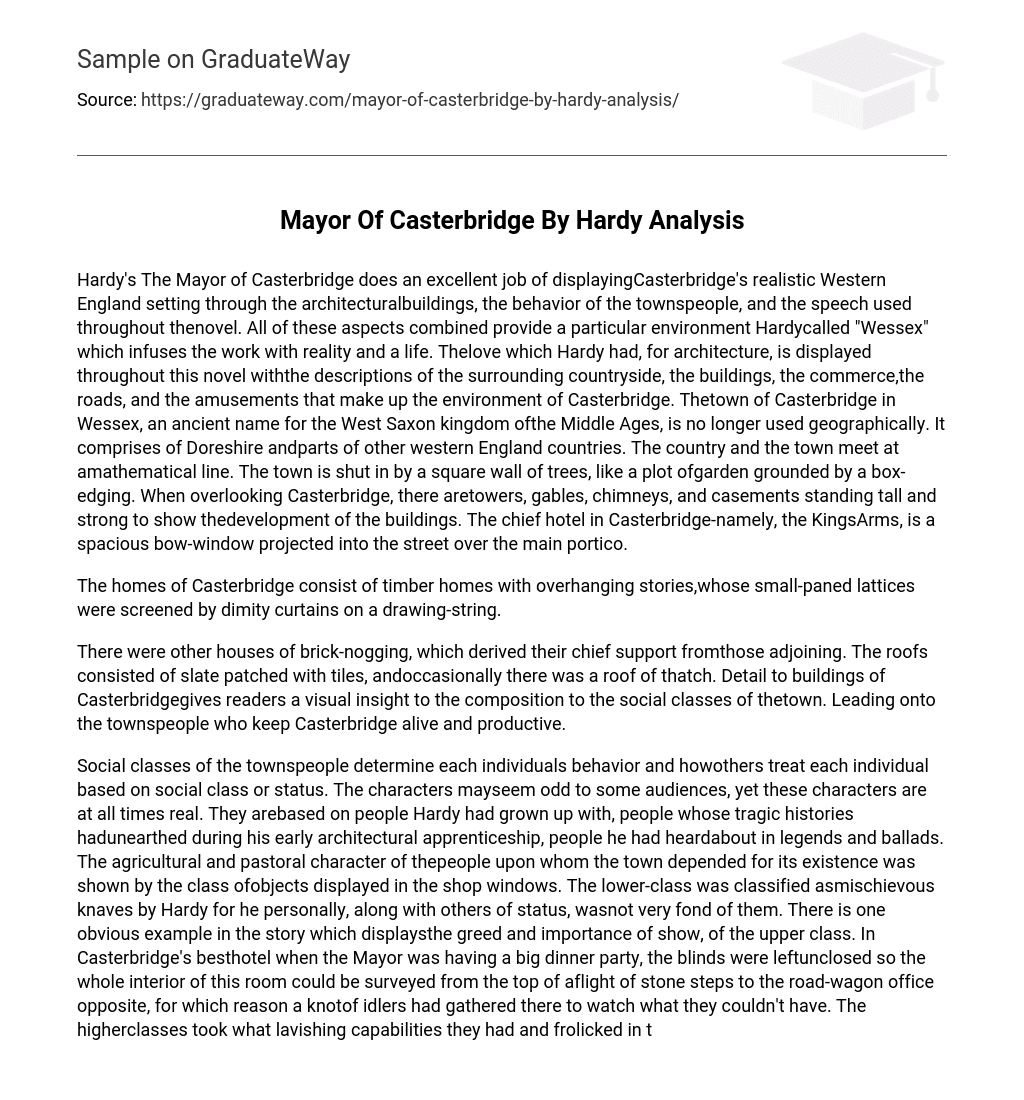Hardy’s The Mayor of Casterbridge does an excellent job of displayingCasterbridge’s realistic Western England setting through the architecturalbuildings, the behavior of the townspeople, and the speech used throughout thenovel. All of these aspects combined provide a particular environment Hardycalled “Wessex” which infuses the work with reality and a life. Thelove which Hardy had, for architecture, is displayed throughout this novel withthe descriptions of the surrounding countryside, the buildings, the commerce,the roads, and the amusements that make up the environment of Casterbridge. Thetown of Casterbridge in Wessex, an ancient name for the West Saxon kingdom ofthe Middle Ages, is no longer used geographically. It comprises of Doreshire andparts of other western England countries. The country and the town meet at amathematical line. The town is shut in by a square wall of trees, like a plot ofgarden grounded by a box-edging. When overlooking Casterbridge, there aretowers, gables, chimneys, and casements standing tall and strong to show thedevelopment of the buildings. The chief hotel in Casterbridge-namely, the KingsArms, is a spacious bow-window projected into the street over the main portico.
The homes of Casterbridge consist of timber homes with overhanging stories,whose small-paned lattices were screened by dimity curtains on a drawing-string.
There were other houses of brick-nogging, which derived their chief support fromthose adjoining. The roofs consisted of slate patched with tiles, andoccasionally there was a roof of thatch. Detail to buildings of Casterbridgegives readers a visual insight to the composition to the social classes of thetown. Leading onto the townspeople who keep Casterbridge alive and productive.
Social classes of the townspeople determine each individuals behavior and howothers treat each individual based on social class or status. The characters mayseem odd to some audiences, yet these characters are at all times real. They arebased on people Hardy had grown up with, people whose tragic histories hadunearthed during his early architectural apprenticeship, people he had heardabout in legends and ballads. The agricultural and pastoral character of thepeople upon whom the town depended for its existence was shown by the class ofobjects displayed in the shop windows. The lower-class was classified asmischievous knaves by Hardy for he personally, along with others of status, wasnot very fond of them. There is one obvious example in the story which displaysthe greed and importance of show, of the upper class. In Casterbridge’s besthotel when the Mayor was having a big dinner party, the blinds were leftunclosed so the whole interior of this room could be surveyed from the top of aflight of stone steps to the road-wagon office opposite, for which reason a knotof idlers had gathered there to watch what they couldn’t have. The higherclasses took what lavishing capabilities they had and frolicked in them for allbelow to envy and want. Although the behavior and mannerism of the townspeopleis blunt, it is realistic and influenced by real life situations through themind of the author. A less obvious yet realistic part of the setting which cannormally be over-looked but is emphasized throughout this novel is the speech,or dialect of the characters and townspeople. Social class is very obviouslyshown through the speech of every individual. Higher class residents ofCasterbridge often spoke much more vulgar terms. They have their own folkdialect which modernly is referred to as slang throughout regions influential onthe environment of the speaker. Speech is also an issue with age and maturitywhich is excellently presented throughout the entire course of the novel inElizabeth-Jane. Hardy shows the gradual change that takes place in her speechthrough the years. In the first portion of the novel when Elizabeth-Jane isyoung, she has a sense of playfulness and good times. But as she grows older andher sorrow increases. Elizabeth-Jane turns more to study and reflection. Towardsthe end of the novel, Elizabeth-Jane is a full grown woman who has her lifeestablished and knows where she stands in social status. She is melancholy andkind. A matronly woman whose speech seems highly studied and affected. Hardydoes an excellent job of taking the little things society tends to overlook andaccenting them to show how realistic each individual is in the town ofCasterbridge. The townspeople, the buildings, and the speech of every individualthroughout the novel.
English Essays





